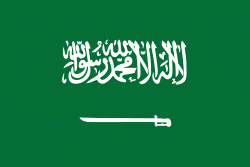Eastern Province (Eastern Province)
More than a third of the population is concentrated in the Dammam metropolitan area. With an estimated population of 1.25 million as of 2019, Dammam, the capital of the province, is the sixth most populous city in the kingdom. The incumbent governor of the province is Prince Saud bin Nayef Al Saud. Other populous cities in the province include Hofuf, Mubarraz, Hafr al-Batin, Jubail and Khobar. The region is extremely popular among tourists for its beaches on the Persian Gulf and proximity to the other countries of the eastern Arab world, such as the United Arab Emirates, Qatar and Bahrain, with the latter being linked to the province via the 25 km (15 mi) long King Fahd Causeway. The region also shares a border with Oman. The province is bordered to the west, from north to south, by the provinces of the Northern Borders, Ha'il, Qassim, Riyadh and Najran.
The Eastern Province encompasses the entire east coast of Saudi Arabia and acts as a major platform for most of the kingdom's oil production and exports. Oil was first found in the country in the Eastern Province, at the Prosperity Well site (formerly known as Dammam No.7). The Ghawar oil field, located in the Ahsa Governorate, measuring 8,400 sq.km. (3,240 sq.mi.) is the largest oil field in the world, and accounts for roughly a third of the kingdom's oil production. The Safaniya oil field, located off the coast of the province, is the largest offshore oil field in the world. The Jubail Industrial City, part of the city of Jubail, the fifth most populous in the province, is the largest industrial city in the world.
The region was home to the Dilmun civilization which was an ancient Semitic-speaking polity in Eastern Arabia. Founded in the late 4th millennium BC and lasting until approximately 538 BC it is regarded as one of the oldest civilizations in the world. Dilmun was an important and prosperous trading centre for millennia with well-developed and long-standing trading, commercial and cultural ties with nearby Mesopotamia in particular and the Indus Valley civilisation. A number of scholars have suggested that Dilmun originally designated the eastern province of Saudi Arabia, notably linked with the major Dilmunite settlements of Umm an-Nussi and Umm ar-Ramadh in the interior and Tarout Island on the coast.
Approximately two-thirds of the province is desert, comprising, from south to north, the Rub' al Khali, Dahna and Nafud deserts, with the Rub' al-Khali alone making up more than half of the area of the province. Areas such as Hafr al-Batin and the Ahsa Oasis have become important sites for desert farming due to the advancements made during the Green Revolution in farming and irrigation techniques.
The entire eastern coast of the kingdom lies in the Eastern Province. The region borders, from north to south, the countries of Iraq, Kuwait, Bahrain, Qatar, United Arab Emirates and Oman.
Map - Eastern Province (Eastern Province)
Map
Country - Saudi_Arabia
 |
 |
| Flag of Saudi Arabia | |
Pre-Islamic Arabia, the territory that constitutes modern-day Saudi Arabia, was the site of several ancient cultures and civilizations; the prehistory of Saudi Arabia shows some of the earliest traces of human activity in the world. The world's second-largest religion, Islam, emerged in what is now Saudi Arabia. In the early 7th century, the Islamic prophet Muhammad united the population of Arabian Peninsula and created a single Islamic religious polity. Following his death in 632, his followers rapidly expanded the territory under Muslim rule beyond Arabia, conquering huge and unprecedented swathes of territory (from the Iberian Peninsula in the west to parts of Central and South Asia in the east) in a matter of decades. Arab dynasties originating from modern-day Saudi Arabia founded the Rashidun (632–661), Umayyad (661–750), Abbasid (750–1517), and Fatimid (909–1171) caliphates, as well as numerous other dynasties in Asia, Africa, and Europe.
Currency / Language
| ISO | Currency | Symbol | Significant figures |
|---|---|---|---|
| SAR | Saudi riyal | رس | 2 |
| ISO | Language |
|---|---|
| AR | Arabic language |

















